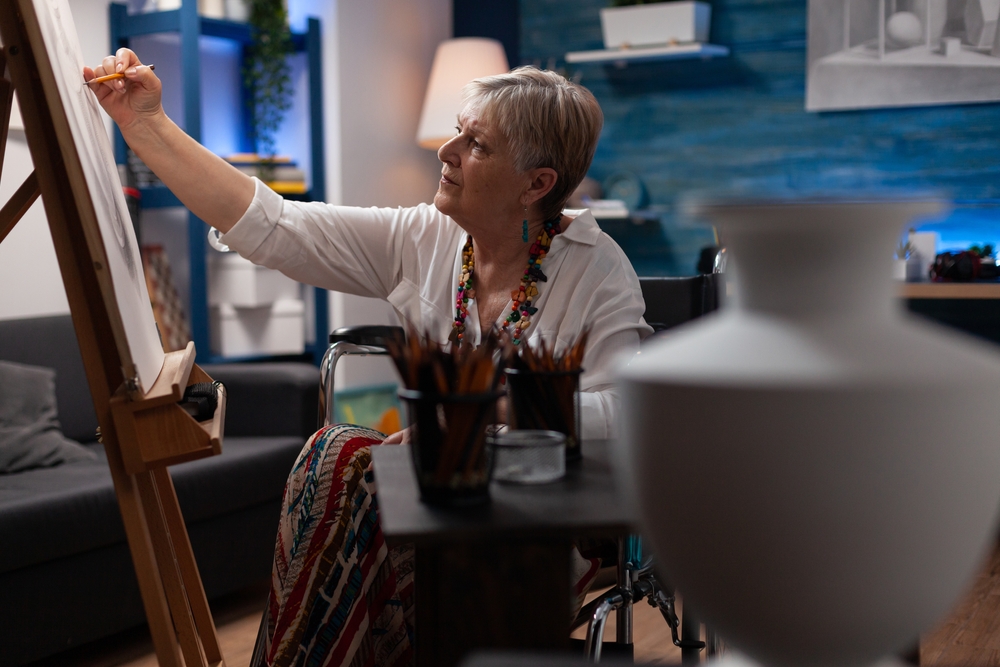When we think of home care, we often focus on physical support — help with walking, bathing, medications. But care goes beyond the physical. Emotional connection and mental well-being matter just as much, especially for those facing illness, memory loss, or isolation.
That’s where creative therapies like music and art can make a real difference. These non-clinical, accessible approaches offer comfort, spark joy, and create meaningful moments between caregivers and the people they care for. With just a little paint, paper, or a favorite song, you can uplift mood, spark connection, and promote well-being in a way that feels personal and easy to integrate into everyday life.
Why music and art therapy matter in home care
Boosting mood and emotional well-being
Creative expression can be powerful medicine. Music has been shown to reduce anxiety, lower blood pressure, and even ease symptoms of depression. Whether it’s singing along to oldies or simply listening to calming instrumental tracks, music helps regulate emotions and create a sense of calm.
Art provides a similar release. Painting, drawing, or coloring gives individuals an outlet to express emotions that may be hard to put into words. These activities can be especially helpful during times of transition, grief, or frustration — common experiences in home care.
Supporting memory and cognitive health

Music and art also offer proven cognitive benefits. For individuals with Alzheimer’s or other forms of dementia, familiar songs can unlock long-term memories and encourage verbal expression. It’s not uncommon for someone who struggles to speak to suddenly sing along when they hear a tune from their youth.
Art therapy activates different areas of the brain and helps strengthen neural connections. Activities like drawing, painting, or working with clay can support focus and problem-solving. For people facing memory loss or cognitive decline, art offers a way to stay mentally engaged and to express thoughts that might be hard to put into words — especially when verbal communication becomes difficult. In fact, creative activities can be a powerful way to express non-verbally with dementia patients, helping them feel seen and understood even when speech is limited.
Learn more: The benefits of home care for dementia patients
Creating meaningful daily rituals
Bringing music and art into the daily rhythm of home care can offer both structure and comfort. Maybe it’s playing a familiar playlist during breakfast, or setting aside time after lunch for a simple watercolor session. These small moments become more than just activities — they create opportunities for social interaction. Whether it’s painting side by side, reminiscing about a favorite song, or simply sharing quiet time together, these rituals help foster connection and build a sense of shared experience.
Music therapy at home
Creating personalized playlists
Start with what they know and love. Build playlists around music from their younger years — songs that bring back good memories. Music that’s soothing (like classical, jazz, or acoustic folk) works well for relaxation, while upbeat tracks can boost energy and motivation.
Try using playlists for specific moods or moments: one for winding down at night, one for gentle movement during the day.
Active participation
Encourage engagement, not just listening. Singing, clapping, tapping to the beat, or even simple dance movements can all be therapeutic. Light instruments like tambourines, shakers, or small drums are great tools for involvement.
If your loved one enjoys company, try incorporating music with family or close friends. Even a short sing-along can bring a sense of connection and joy.
Art therapy at home
Simple, safe art activities
You don’t need fancy materials to get started. A box of crayons, a few watercolor paints, or even old magazines for collaging can open the door to creativity. The goal isn’t perfection — it’s expression. Many people enjoy the simple act of putting color to paper, tearing textures, or experimenting with shapes in a way that feels calming and free.
If your loved one has arthritis, tremors, or limited grip strength, try adapting the tools. Larger paintbrushes, sponge dabbers, or even finger painting can make the experience more comfortable — and just as meaningful.
Encouraging creativity without pressure
Art doesn’t need to be perfect to be powerful. What matters most is the experience — not the end result. Taking time to create, without rules or expectations, can be incredibly grounding. For those navigating anxiety, recovering from a stroke, or coping with memory loss, it’s a gentle way to slow down and feel present. There’s no right or wrong here — just the freedom to explore and express, one brushstroke or scribble at a time.
Easy ways to incorporate music and art therapy at home
Getting started with no special training
You don’t have to be a therapist to bring the emotional and cognitive benefits of music and art into your home. There’s no need for special equipment, training, or a perfect plan. Use what you have — a smartphone, basic supplies, and a little patience — and let the creativity unfold naturally. There’s no right or wrong way to do it.
Here are some simple ways to start:
Easy way to incorporate music at home:
- Create decade-based playlists: Songs from your loved one’s teens or twenties can trigger strong memories. Try searching Spotify or YouTube for playlists based on the decade they grew up in — familiar music from those years often sparks the strongest emotional connections.
- Use music to shape the day: Soft piano or acoustic tracks in the morning can ease into the day, while livelier tunes in the afternoon might lift energy. Familiar lullabies or gentle instrumentals can help wind things down at night.
- Make it interactive: Clap, hum, or tap along together. Even light percussion (like a shaker or small drum) encourages engagement and helps stimulate coordination.
- Pull from personal history: Music tied to meaningful events — wedding songs, lullabies, religious hymns, or cultural favorites — often sparks connection and memory.
- Try playing music during care routines: Gentle background music during bathing, dressing, or meals can create a soothing rhythm and make caregiving feel less clinical.
Easy way to incorporate art at home:
- Keep it simple and accessible: Crayons, watercolor, colored pencils, or even finger paints are great. Don’t worry about what the final result looks like — just focus on the experience.
- Adapt as needed: For those with arthritis or tremors, larger paintbrushes, sponge tools, adaptive grips, or finger painting can make the activity easier and more enjoyable.
- Make it a shared experience: Sit down together and create side-by-side. There’s no need for instruction — just enjoy the act of making something.
- Use guided art videos: Try beginner-friendly YouTube channels or simple follow-along tutorials. These can be especially helpful if you’re unsure where to begin.
- Create a memory board: Use old photos, ticket stubs, postcards, or magazine clippings to build a collage that celebrates meaningful moments and sparks storytelling.
Whether it’s listening, singing, painting, or cutting up magazine pages, what matters most is that you’re doing something together. These shared experiences help build connection, reduce stress, and create moments of joy and meaning.
If you’d like help bringing more creativity into your care routine, reach out to our compassionate care team. Many of our home health aides are experienced in using music and art as part of everyday support — and we’re here to help you get started in a way that feels right for your family.
When to consult a certified therapist
Some situations may call for a professional touch. If your loved one is struggling emotionally, showing signs of depression or withdrawal, or experiencing advanced dementia, a licensed music or art therapist can provide more structure and therapeutic guidance.
Look for local or virtual services through home health agencies, senior centers, or hospital programs. You can also contact our team for support or referrals.
Reach out for support
Music and art therapy are simple, powerful ways to enhance home care. They help individuals feel seen, heard, and connected — sometimes in ways that words alone can’t achieve. Whether you’re caring for someone with dementia, chronic illness, or just hoping to improve emotional quality of life, creative therapies can make everyday care more meaningful.
If you’re looking for personalized support, we’re here to help. Learn how we use creative, whole-person approaches to promote well-being and bring more comfort, joy, and connection to everyday care at home.

